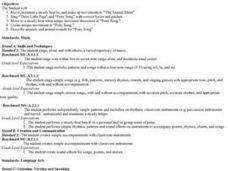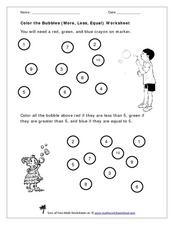PHET
Color Vision
Humans can only see visible light, but some insects can see ultraviolet light. Through a simulation, pupils explore how we see colors using one bulb. It moves on to demonstrate how we see colors by mixing three different bulbs (red,...
John F. Kennedy Presidential Library & Museum
Red States/Blue States: Mapping the Presidential Election
Young historians investigate how voting patterns have changed by comparing the outcome of the 1960 election to the outcome of the recent election. A creative final assessment has participants making a news show wherein they provide...
NASA
Water Works on a Blue Planet
Keep within a water budget. Learners find out that less than 2.5% of Earth's water is available to drink—and that there is a fixed amount of water. Scholars read an interesting article comparing the available water to a game of Monopoly...
Curated OER
How a Blue Crab Changes as it Grows
Pupils explore the BlueCrab Archives website. It includes pictures of a blue crab as it goes through the stages of molting. Students often become confused with the term molting since it is used in different ways in the animal world....
Curated OER
Island of the Blue Dolphins: Chapters 1-2 Quiz
In this Island of the Blue Dolphin worksheet, students identify vocabulary words from chapters one and two in this book. They match the vocabulary word to the best definition Students complete six problems.
Curated OER
Lambert, Hendricks, and Ross, Moanin,' Payin' Your Dues
Young scholars examine the musical styles of call and response and the blues while delving into the difficult lives of many jazz musicians. Travelling in the South was challenging for black musicians during this time and the difficulties...
Curated OER
ESL Integrated Literature Unit
High schoolers read and analyze information related to the book Island of the Blue Dolphin. They select appropriate information for the purpose of investigating part of the book.
Curated OER
The Pony Song
Students sing "Three Little Pigs", the "Pony Song", and "The Animal Blues" in this elementary school music lesson. National and State Standards are addressed. Assessment rubric is included for grading and student evaluation.
Curated OER
Green as a Bean
Students draw what they would be if they were green, red, yellow, or blue. In this drawing lesson plan, students have to draw what they would like to be based on a given color.
Curated OER
Color the Bubbles (More, Less, Equal)
Combine coloring and number comparisons with your youngsters. They use color coding to identify numbers that are less than, greater than, or equal to five. The 20 numbers are enclosed in bubbles, making this more of a fun activity. Note...
K-5 Math Teaching Resources
Color Words
Brighten up your primary grade classroom with this series of printable color words. Covering all of basics from red and blue to black and pink, this simple resource is perfect for use with young children who are just beginning to learn...
Curated OER
"Why Is the Sky Blue?"
Learners investigate why the sky is blue and the sunset is red. They are asked why do you think that we see the sky as blue? Students write a hypothesis on their "Blue Sky Lab Sheet". They explain why they think that the sky is blue...
Curated OER
Why is the Sky Blue?
Students explore diffusion or scattering of light. For this physics lesson, students explain why the sky is blue and sunsets/sunrises are red.
Curated OER
Blues and Folk Music Workshop
In these informational texts worksheets, students read the detailed flyer for the Blues and Folk Music Workshop. Students then answer 8 multiple choice questions about the text.
Curated OER
A Guide Through the Culture of the Blues
Learners examine the history of blues music and discover how it relates to the music of today. As a class, they listen to the drum songs of Africa and compare it to the use of drums in pop music today. Using the internet, they research...
Curated OER
The Little Blue Engine
Young scholars listen to a read aloud of Shel Silverstein's, The Little Blue Engine. They design and build a Lego train that climbs a three foot incline, one foot at a time. They draw and write about their design.
Curated OER
Colorimetric Determination of the Concentration of Blue Food Coloring in Sport Drinks
Seventh graders determine the amount of blue food coloring in sports drinks and plot the concentration and absorbance data. They summarize the data and determine why companies need to know the amount of chemicals in their products.
Curated OER
Blue Cube, 27 Little Cubes
In this geometry worksheet, 10th graders calculate how many blue face. Students calculate the volume of the two cubes. There is an answer key.
Curated OER
Picture Scramble Puzzle- Chipmunk, Blue-Winged Teal and Pickerel
In this picture scramble puzzle worksheet, students arrange the numbers in the lettered boxes to create the image of an Eastern chipmunk, a blue-winged teal, or a pickerel. They see a picture of each animal next to the puzzle.
Curated OER
Bird Coloring Page- Barn Swallow, Common Yellowthroat, Northern Cardinal, Blue Jay
In this coloring worksheet, young scholars color 4 black-line pictures of birds. They color a Barn Swallow, Common Yellowthroat, Northern Cardinal, and a Blue Jay.
Curated OER
Endangered Animal Coloring Page
In this endangered animal worksheet, students color a picture of a blue whale. Students then draw its natural habitat all around it.
Curated OER
Writing the Blues
Learners assess the blues as musical poetry. They place the writing of blues music in historical context and write (and read) their own blues lyrics. They perform for the class and others.
Curated OER
What Can Be Blue?
In this reading activity, students inspect 6 pictures and read the sentence accompanying them. Example: "Tricycles can be blue." Students color each picture a shade of blue.
Curated OER
Spot the Differences: Great Blue Herons
In this science and visual discrimination worksheet, students spot 6 differences between the two pictures of the great blue heron.

























